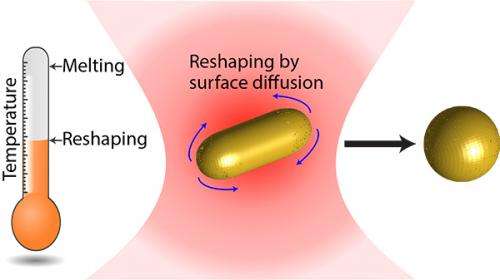Landmark discovery in gold nanorod instability

Researchers at Swinburne University of Technology have discovered an instability in gold nanoparticles that is critical for their application in future technology.
Gold nanorods are important building blocks for future applications in solar cells, cancer therapy and optical circuitry.
However their stability is under question due to their peculiar reshaping behaviour below melting points.
A solid normally does not change its shape unless it reaches its melting point, or surface melting points. It is also known that the melting point for nanoparticles is suppressed due to their size.
PhD student Adam Taylor (now a postdoctoral researcher at Swinburne) said it came as a surprise that reshaping is observed well below these melting points. Until now, no one could explain this peculiar behaviour.
"In our work, we have discovered both theoretically and experimentally that the reshaping mechanism for nanoparticles below melting point is surface atom diffusion, rather than melting," Mr Taylor said.
Surface atom diffusion is a process involving the motion of molecules at solid material surfaces that can generally be thought of in terms of particles jumping between adjacent adsorption sites on a surface.
"Surface atom diffusion always existed in bulk solids, but this is the first evidence that its effect is enhanced at the nano-size, dominating over the traditional theory of melting," Associate Professor James Chon, who is supervising Mr Taylor's research, said.
Mr Taylor said the more finely nanoparticles are shaped, the less stable they become.
"This is important, for example, for solar panel manufacturers as the more needle-like these nanoparticles are shaped the less stable they become. If you put these particles into a solar panel to concentrate light they may not last long in the sun before they degrade," Mr Taylor said.
"This discovery will be crucial for future applications of gold nanorods, as people will need to reconsider their stability when applying them to solar cells, cancer therapeutic agents and optical circuitry."
More information: "Below Melting Point Photothermal Reshaping of Single Gold Nanorods Driven by Surface Diffusion" ACS Nano, Article ASAP. DOI: 10.1021/nn5055283
Journal information: ACS Nano
Provided by Swinburne University of Technology




















